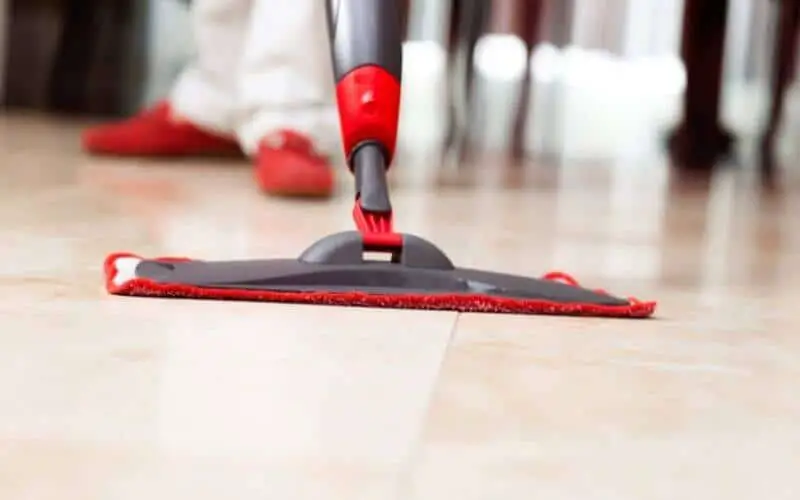The steam mop is a wonderful and convenient cleaning tool with many advantages like loosening dirt and grime off the floor and killing bacteria and dust mites on the floor. This makes it a faster and more sanitary way to clean.
Unfortunately, steam cleaning cannot be used on all floors, which brings us to an important question: What floors can you use a steam mop on? Steaming can only be used on ceramic and porcelain tile floors.
Read: Can you put disinfectant in a steam mop
Advantages of Steam Cleaning
Table of Contents
As mentioned, steam cleaning is a faster and sanitary way to clean your floors. Most homeowners have embraced this method of cleaning. Some perceived advantage of steaming cleaning includes:
1. It saves time that would have been spent on mopping the floor over and over again.
2. It loosens dirt and grime off the floor. This is unlike mopping, which absorbs the dirt.
3. The heat of the steam can kill most of the bacteria and dust mites on the floor. This becomes useful if you’re struggling with pest infestation on your floors.
4. It is a faster, more sanitary, and efficient way of cleaning.
5. When compared to mopping, it is an extremely convenient way to quickly touch up floors.
Read: Is vinyl floor heat resistant?
Disadvantages of Steam Cleaning
It is often said that everything with an advantage has a proportional disadvantage. Now, it’s time we examine some cons of steam cleaning.
To understand some of these disadvantages, we will run you through how steam cleaning works. Steam cleaners work by forcing steam onto a floor’s surface, this is done under high pressure to loosen the dirt, which evaporates immediately.
This sounds pretty awesome, right? But the idea of steam cleaning means that you’re operating at a high pressure which forces moisture into the joints and layers of your floors. It might be argued that the moisture evaporates quickly, but there is a caveat.
Constantly dampening your floor could make it swell, curl, or de-laminate. It follows that it is not safe to steam-clean floors that are likely to swell under excessive moisture like solid wood, engineered, laminate, and vinyl floors.
Sometimes the effect of steam cleaning on the floors mentioned includes discoloring, warping, cupping, or cracking depending on the floor.
Using a steam mop on the floors mentioned here can cause a buildup of mold and mildew, leading to a musty smell as well as damage.
Irrespective of what is marketed by most manufacturers, it is not safe to steam clean solid wood, engineered, laminate, and vinyl floors, even at low or medium pressure.
Read: Why is my vinyl floor buckling
What Floors can you Use a Steam Mop on?
As already emphasized, the steam mop shouldn’t be used on solid wood, engineered, laminate, and vinyl floors. It thus forces the question, what floors can you use a steam mop on?
Only porcelain and ceramic tiles should be steamed cleaned. These floors are durable solid and can withstand the powerful cleaning that steam mops are known for.
Steam cleaning is best used on flooring that has no such gaps and isn’t likely to warp in high temperatures, such as ceramic tile floors and porcelain floor tiles. We will examine how to steam clean ceramic tile floors and porcelain floor tiles.
How to Steam Clean Ceramic and Porcelain Tile Floors
Using a steam cleaner to clean ceramic and porcelain tile floors removes sticky residue and disinfects the tile surfaces. Follow the steps to steam clean your ceramic floor tiles.
1. Start by sweeping the floor with a broom or dust mop. If you have some cobwebs hanging around the floor corners, dust it out with a rag.
2. Fill the water tank on your steam cleaner with distilled water. Do not add any cleaning products to your water tank.
3. Attach the microfiber cloth that comes with your steam cleaner to the steam cleaner head.
4. Plug your steam cleaner into the wall outlet. It might take several minutes for the water in the tank of the steam cleaner to heat up.
5. Depending on the model of your steam cleaner, you can either start steam cleaning by pumping or squeezing the handle on your steam cleaner.
Move the steam cleaner’s head back and forth over your tile to clean your ceramic/porcelain floor tiles.
6. Once you’re done, unplug the steam cleaner from the wall outlet and remove the microfiber cloth from the steam cleaner. Give your tile some time to dry before stepping on it.
Read: How to clean tile floors naturally
Frequently Asked Questions
Is it ok to Use a Steam Mop on Vinyl Flooring?
No. it is not ok to use a steam mop on vinyl floorings. Irrespective of what is marketed by manufacturers, steam cleaning vinyl floors can breach the adhesive used on the floor and end up damaging it.
Do not even steam clean vinyl floors on low pressure; it is better to err on the side of caution.
Is a Steam Mop Safe for Hardwood Floors?
No! No! No! don’t ever use a steam mop on hardwood floors no matter how tempted you are. Steam mopping hardwood floors will end up warping the wood, which will inherently lead to wood damage.
Is It Better to Steam or Mop Floors?
It depends on the type of floor; it’s best to steam clean ceramic tile floors and porcelain floor tiles while solid wood, engineered, laminate, and vinyl floors should be mopped.
Read: 9 best bathroom steam cleaner
Conclusion
We hope this post answers the question: What floors can you use a steam mop on? Now you know that only ceramic tile floors and porcelain floor tiles should be steam cleaned.
Remember that only water should be used in steam cleaning. Many homeowners make the mistake of adding diluted chemicals to the tank of the steam cleaner, which will end up leaving the floor sticky.

